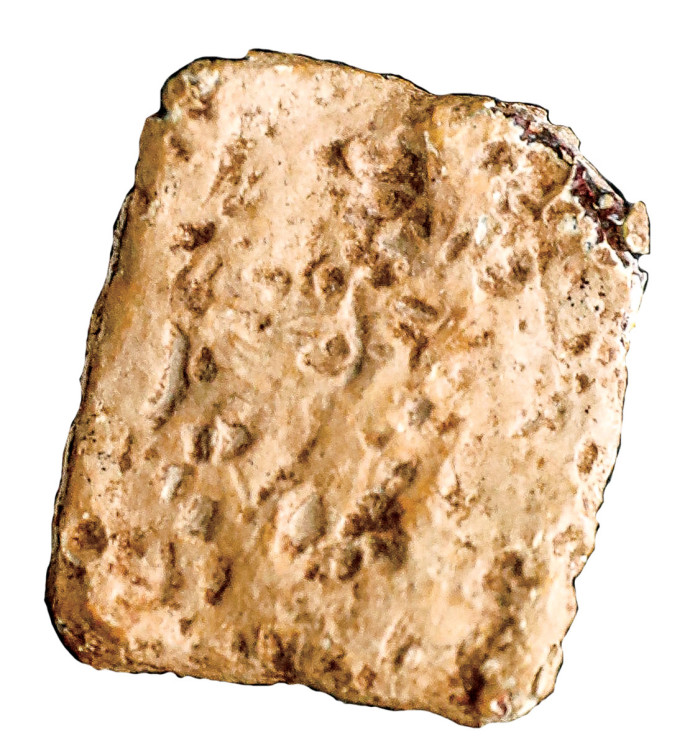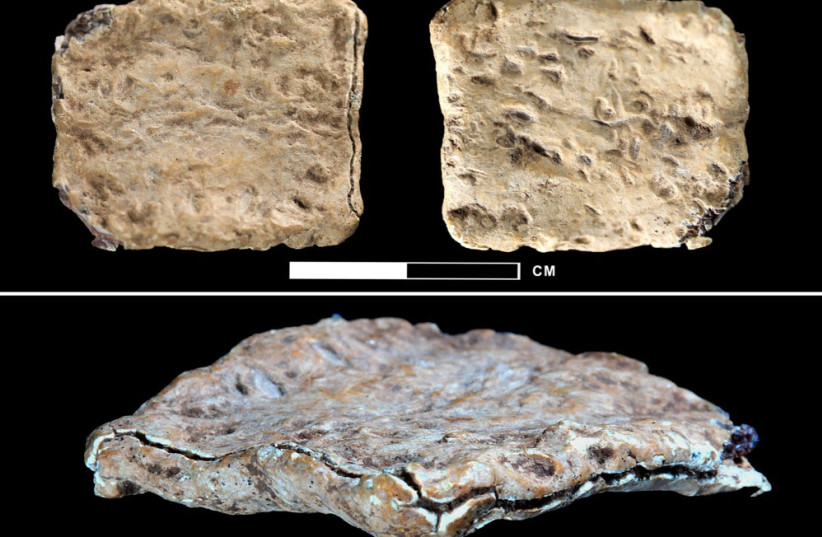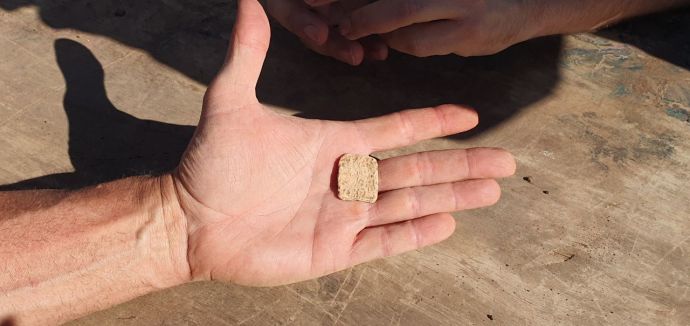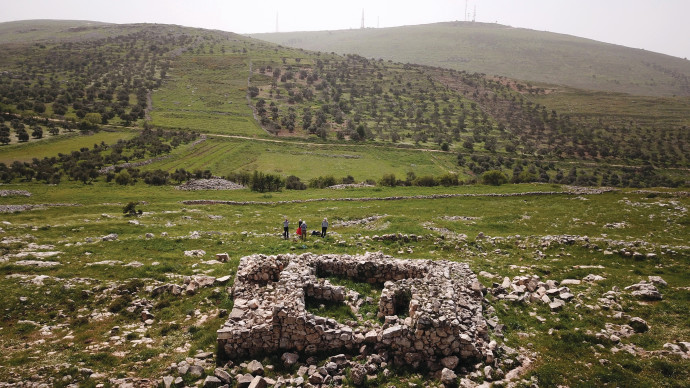This month’s revelation of the text inscribed on a “curse amulet” from Mount Ebal rocked the world of archaeology because of the implications it has on theories of how and when the Bible was written, according to Dr. Scott Stripling, director of excavations for the Associates for Biblical Research (ABR) at ancient Shiloh, who led the research on the amulet.
In a media conference on Thursday, Stripling made a new set of astounding announcements about the find.
Recall, the lead amulet measuring two centimeters square was found by wet-sifting material taken from a site on Mount Ebal excavated by Prof. Adam Zertal more than 30 years ago. Folded in half, the letters inscribed in the lead foil were indecipherable and the metal was too brittle to unfold. So, the amulet was sent to researchers in Prague who used tomographic scans - similar to medical diagnostic CT scans - to recover the hidden text.
The scans revealed an ancient proto-alphabetic Hebrew inscription consisting of 40 letters comprising 23 words. After deciphering the text, it was determined to be a defixio: a curse tablet.
Cursed, cursed, cursed - cursed by the God YHWH.You will die cursed.Cursed you will surely die.Cursed by YHWH – cursed, cursed, cursed
The word ‘cursed’ appears 10 times and the name of God appears twice.
“The name of God on the tablet uses the three-letter spelling: Yud Heh Vav,” Dr. Stripling said. “What we commonly see in the Bible is the four-letter tetragrammaton spelled Yud Heh Vav Heh. But we also have in the Bible the three-letter and even two-letter spelling. In the early period, there was no standard spelling.”
If accurate, the text is now believed to be the oldest example of proto-alphabetic Hebrew discovered to date in Israel. This would also be the oldest appearance of the name of the God of Israel.
“In working to establish the age of the tablet, analysis of the lead determined it was from a mine in Greece that was active during the late Bronze Age (1550 BCE – 1200 BCE),” Stripling said. “The epigraphic nature of the proto-Hebraic writing was also consistent with this period, as was the archaeological context in which the amulet was found.
“This type of writing is much more characteristic of the very beginning Late Bronze II age (1400 BCE – 1300 BCE) than of the end," he continued. "For those who hold a late date of the Exodus, they could argue that they were still using an archaic script, but it is more logical to say the Exodus was earlier. This is really problematic for people who say the Exodus was later or metaphoric.”
This early appearance of God’s name has implications for theories about how and when the Bible was written.
“This is a problem for the Documentary Hypothesis that states that the Bible was composed in different sections, hundreds of years apart and later redacted,” Stripling explained. “This is also a challenge to the theory that states that Moses could not have written the Pentateuch because an alphabetic script did not exist early enough. Here we see that it did exist.”
The appearance of a written language on Mount Ebal is consistent with a scenario in which the nation participated in a covenant ceremony as described in the Bible.
“There is a presumption of literacy, that Joshua can write and that the people can read,” Stripling said.
Additional findings
He added that Dr. Zertal found flat plaster-covered stones buried inside the altar consistent with the biblical account:
As soon as you have crossed the Yarden into the land that Hashem your God is giving you, you shall set up large stones. Coat them with plaster and inscribe upon them all the words of this Teaching. When you cross over to enter the land that Hashem your God is giving you, a land flowing with milk and honey, as Hashem, the God of your fathers, promised you (Deuteronomy 27:2-3).
Stripling said that the stones are about to undergo examination.
He also revealed that they found a metal stylus at the site of the kind that would be used to inscribe the metal amulet. He referred to the book of Job, believed to have been written between the 7th and 4th centuries BCE, which seems to be describing just such a writing process:
O that my words were written down; Would they be inscribed in a record, Incised on a rock forever With iron stylus and lead (Job 19:24).
Stripling said that he blelieves that the tablet verifies Zertal’s assertion that the site he excavated in the 1980s on Mount Ebal was the altar of Joshua.
“At that time Joshua built an altar to the LORD, the God of Israel, on Mount Ebal” (Joshua 8:30).
Zertal’s assertion that Mount Ebal was the scene of Joshua’s covenant ceremony was received at the time with skepticism.
“The lead amulet absolutely supports Zertal’s assertion that Mount Ebal was the site of Joshua’s altar,” Stripling said. “It was found In an area called El Burnat in Arabic, a stony ridge, on the second step of the mountain. Two altars were found: an older circular altar and then a later rectangular altar that was later intentionally covered by a mantle of stones. It’s at the right place, at the right time, and has the right stuff.”
Stripling even suggested that the lead amulet might have been part of that ceremony described in the Bible.
“There’s no way to be certain but it is possible,” he said. “If you take the curse inscribed on the inside of the tablet, and there is additional cursing inscribed on the outside, that is a summary of Deuteronomy, which has a list of blessings and curses. That is how covenants were made in the late Bronze Age. This is a legal type of document. This is a self-imprecatory curse, with the author saying that they are binding themselves, saying that these curses will happen to them if they violate God’s covenant. More importantly, the amulet was found in the altar context. This was to say that if they broke the covenant, they would come to the altar as taking responsibility for their actions.
“When the tablet is sealed, it is binding,” he continued. “This could be one tablet and this is the titular tablet from the ceremony binding the whole nation in the covenant. But if we sift through the rest of the material from the altar and find a bunch more, then maybe it was that individuals were coming in over a period of time to confirm the covenant.”
Stripling explained that curses, what he prefers to call “consequences,” were an essential part of the relationship between God and man.
“The concept of curses starts back in the Garden of Eden. This introduces the concept of consequences,” he said.For this reason, the altar was located on Mount Ebal.
“The altar was on the mountain of curses, not on Gerizim, which was the mountain of blessings,” Stripling said. “We don’t need an altar when we are in the blessings. When we break the covenant, when we are in sin, that is when the altar comes into play.
“It is only through the shedding of blood that there is remission of sin. If we repent and accept the consequences, we are expiated from the curse.”




